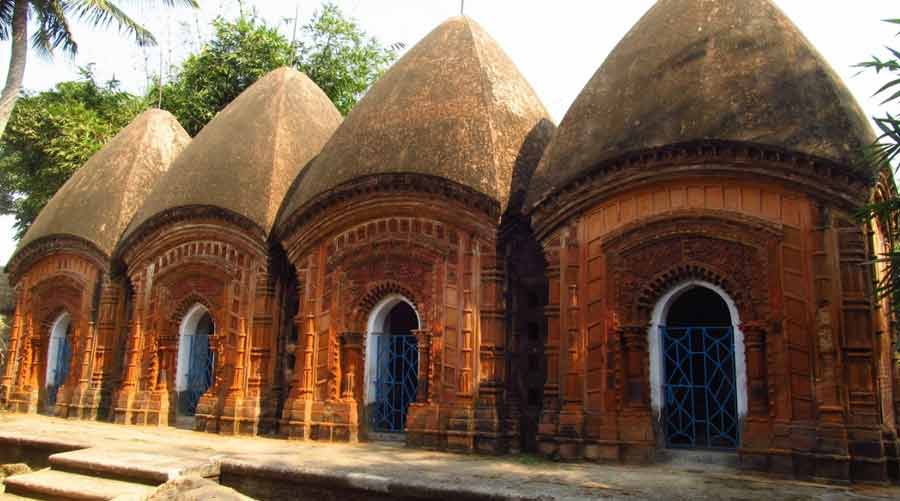Bolpur and Santiniketan are perennially popular getaway destinations for Kolkatans. On your next trip, instead of the regular tourist attractions, step off the beaten path and explore the age-old brick temples adorned with exquisite terracotta work that dot the villages and towns within a 30-km radius of Bolpur.
One can visit these magnificent structures following three routes. For the first, it is recommended heading to the temples of Surul, Supur and Itonda. The second and third routes cover the temples of Illambazar, Ghurusha and Joydeb Kenduli to west of Bolpur, and Nanoor and Uchkaran to the east.
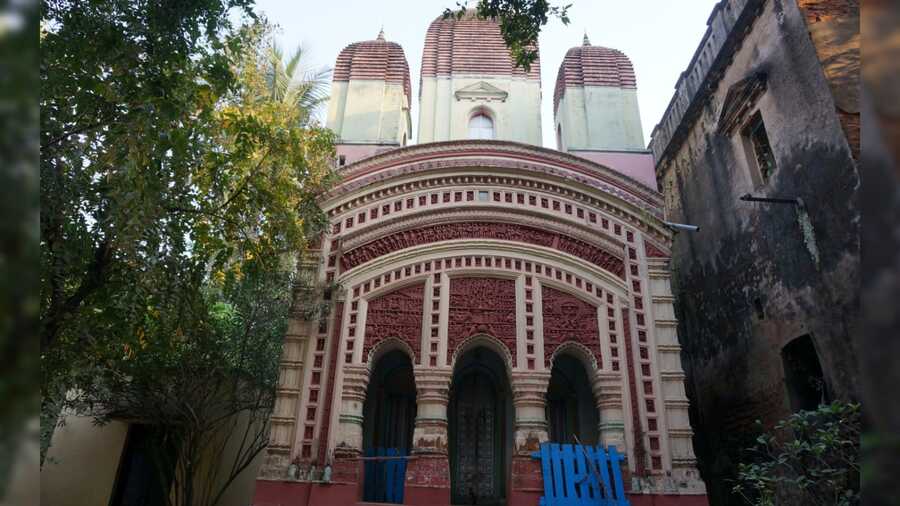
The Pancha Ratna Lakshmi Janardan Temple in Illambazar
Route: Illambazar, Ghurisha and Joydeb Kenduli
Temples of Illambazar

The octagonal Gouranga Mahaprabhu Temple at Illamabazar
About 19km west of Bolpur is the erstwhile port town of Illambazar. The first temple to visit is the unique octagonal-shaped Gouranga Mahaprabhu Temple. It is located inside a busy bazaar and it is a good idea to get to the spot early in the morning to avoid crowds.

The ‘Goshtho Leela’ of Krishna in terracotta on the Gouranga Mahaprabhu Temple in Illambazar
In the terracotta panels adorning the temple, Illamabazar’s past as a port town under the East India Company is reflected in the numerous sailboat motifs and the European-inspired garb of the figurines along with Corinthian columns and shuttered windows. Mythology and folklore are the other common themes. A chalchitra-style panel shows goddess Durga and her family, there are etchings of Krishna’s childhood events, of Bhagirath bringing Ganga to the earth and the battle between Rama and Ravana.
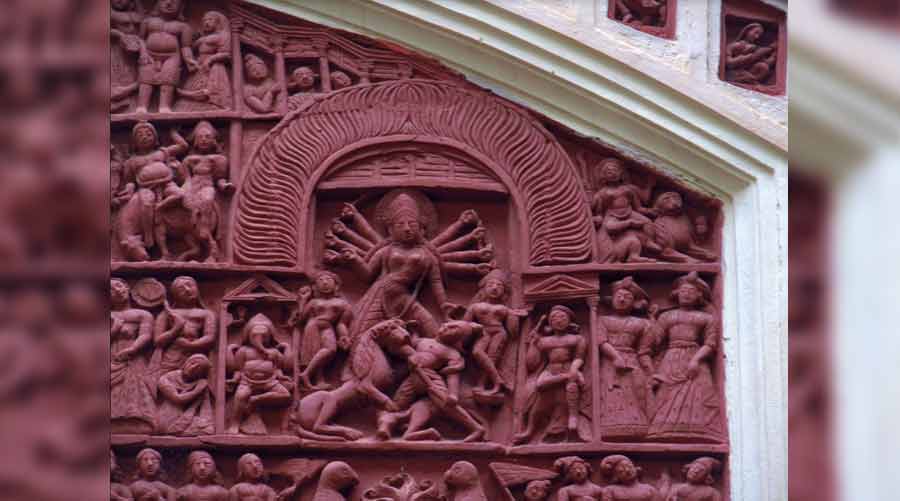
A chalchitra-style panel shows goddess Durga and her family at the Pancha Ratna Lakshmi Janardan temple
Among the other interesting terracotta-adorned structures are the Pancha Ratna Lakshmi Janardan Temple, founded in 1846, and the deul-style temple of Rameshwar Shiva. The semicircular panel along the top of the arch of the Lakshmi Janardan temple deserves a special mention because of its intricate handiwork. Panels along the central arch show scenes from Krishna Leela, the enthronement of Ram, and of Durga slaying a demon. At the Rameshwar Shiva temple, a huge panel shows goddess Jagadhatri sitting on a lotus between two lions.
Temples of Ghurisha
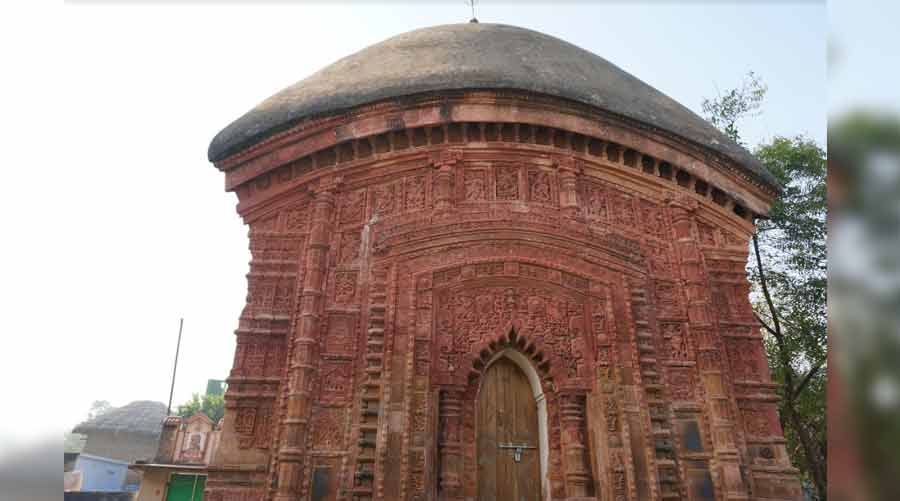
Ghurisha’s ‘charchala’ temple of Raghunathjee dates back to 1633
Further away, about 26km from Bolpur, Ghurisha’s charchala temple of Raghunathjee that dates back to 1633, is one of the oldest temples in Birbhum, contemporary to those built by the Malla kings in Bishnupur. It is said that it once it housed a golden image of Rama, which was purloined by Maratha raiders in the mid-18th century.
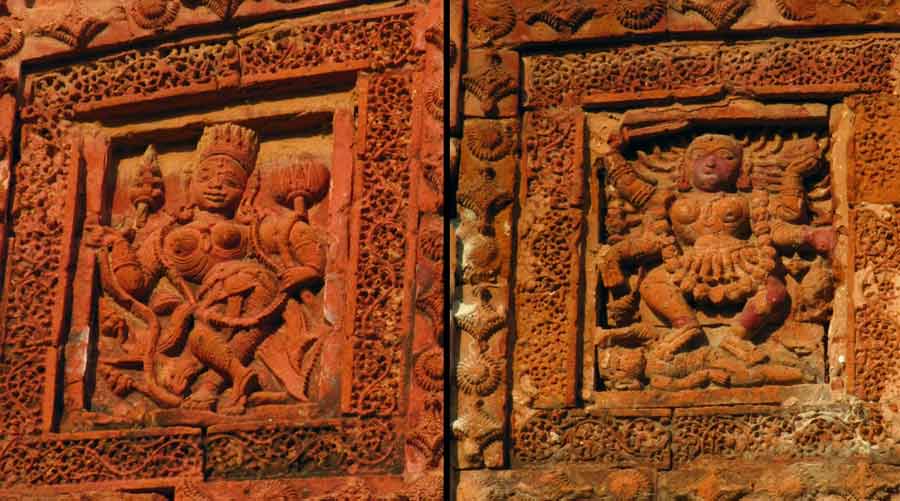
The temple’s large terracotta panels, like these with figurines of goddesses (left) Saraswati and (right) Kali, show the artistic style of the 16th and 17th centuries
The temple’s large terracotta panels, with the spontaneous style of the 16th and 17th centuries, show interesting motifs and figurines — Shiva astride a bull, a four-headed Brahma on his swan, Krishna astride Garuda, Saraswati playing the veena and a battle between Ram and Ravana. The most impressive of all the figurines is that of Chamunda.
The changes in terracotta art and its motifs can be understood when comparing the panels of the Raghunathjee temple to those seen adorning the Navaratna Gopal Lakshmi Janardan Temple nearby, which was built in 1739. In the span of a century, the architects of the temples had changed. Earlier, the art was done mainly by members of the Sutradhar community. Later, it was the Kumbhakars, who were primarily potters, who began making the artwork in the temples.

The (left) Navaratna Gopal Lakshmi Janardan Temple of Ghurisha has a (right) large terracotta panel with a figure of Tripurasundari
Many say that this change brought about changes in the aesthetics of the motifs. Nonetheless, they are beautiful works of art. A large panel with a figurine of Tripurasundari, along with the ones showcasing Dasa Mahavidyas and the enthronement of Rama are noteworthy. There is also a panel depicting Shri Chaitanya and Nityananda Mahaprabhu singing and dancing with other Vaishnavites, and one that shows a warship carrying English soldiers.
Temples of Joydeb Kenduli
Another 5km away is the site of the famous Joydeb Kenduli Mela. The other important thing associated with the village is the 17th-century Navaratna Radha Binod Temple, which is under the care of the Archeological Survey of India.
The south-facing temple, with a triple-arched entrance, has terracotta work left only on its front. The panel over the central archway has detailed battle scenarios from the Ramayana, and motifs from the Dasavatar, as well as figures of Vishnu, Brahma, Shiva, Vayu, Indra and Yama.
Route: Nanoor and Uchkaran
The final route on the journey to see the terracotta temples around Santiniketan goes east from Bolpur town into Nanoor, 20km away, and Uchakaran, a further 5km along.
Temples of Nanoor

The cluster of temples at the site of 14th-century poet Boru Chandidas’s ancestral home
Among the several temples that stand on the site of 14th-century poet Boru Chandidas’s ancestral home, 14 temples have been renovated and maintained by the ASI and only two have considerable terracotta art left on their walls.
The most famous temple here is the Bishalakshmi Temple, locally known as the Basuli Temple. The poet’s father Bhavanicharan was said to be the priest of this temple. However, while the mound of the house dates back to the 14th century, the temples are from the 17th and 18th centuries. The original deity of the Basuli Temple, a 10-inch-tall figurine with four hands and made of brass and bronze, was stolen in 2001 and a replica has been placed in its stead.

Stuccos with floral motifs in one of the four ‘charchala’ temples at Nanoor
Terracotta art can be found on only the twin aatchala Shiva temples. The charchala temples have stucco art on them, and are among the few remaining specimens of brick temples in Bengal with such art still on them.
Temples of Uchkaran
The four charchala temples of Uchkaran are protected by the state's archeology department. The terracotta art on the arches showcase battle scenes, mostly from the Ramayana with fierce demons and a detailed visual of a fight between Rama and Ravana. There is also imagery of Shamshan Kali, Dakshina Kali and goddess Durga in her shinghabahini form astride a lion, attacking demons. One can also find Vishnu astride Garuda, a four-headed Brahma on his swan and Sage Narada with a veena in hand.

Panels showcasing two forms of Kali, and ‘shinghabahini’ Durga demolishing demons in a temple at Uchkaran
For lovers of history and art, these heritage routes from Bolpur make for an enriching experience and add something new to a favourite getaway.


